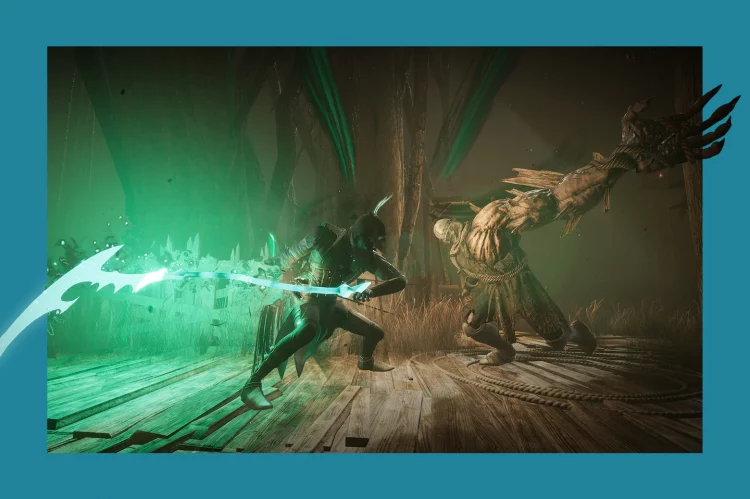Placeholder while article actions load
Available on: PlayStation 5, PC, Xbox Series X | S
Developer: OverBorder Studio | Publisher: Team17
Step into “Thymesia,” and you arrive in a kingdom blighted by a terrible plague. From peasants to lords, its people have mutated into mindless frenzied husks, and efforts to concoct a vaccine only seem to have made things worse. Aside from a couple of alchemists still working to solve the riddle, you won’t meet anyone unscarred by the pandemic. Even protagonist Corvus has been afflicted, albeit in a different way that grants him unique plague-based powers, helping him to fend off the monsters.
“Thymesia” is itself a mutant of sorts, infected by the contagious influence of From Software’s games, whose cursed lands and opaque designs surge through its veins. Pull up “Thymesia’s” bloody floorboards and you’ll see Hidetaka Miyazaki’s signature etched in the foundations. It exhibits all the classic symptoms of a Soulslike — branching level designs that loop back on themselves, sparse rest points, currency that gets left behind when you die, teasing you to retrieve it — while its setting and lore pull inspiration from the streets of “Bloodborne’s” Yarnham. There’s a gothic tint to “Thymesia’s” medieval locales, a plot that similarly centers on experiments with blood, and the black-clad Corvus, adorned with feather cape and plague mask, could be the brother of “Bloodborne’s” Eileen the Crow (the word “Corvus” refers to birds of the crow family).
Yet dig even further, and you’ll find that the biggest influence is “Sekiro: Shadows Die Twice.” Just as From Software shifted its formula away from RPG territory with its tale of a rogue shinobi, “Thymesia” is primarily a character action game, where leveling up is simplified to boosting one of three traits — sword attacks, claw attacks and health — then picking abilities from a skill tree. As such, although you can customize your play style, Corvus remains a particular kind of fighter.
On paper, “Thymesia” thus reads like a mishmash of other people’s ideas; like a crow indeed, grabbing whatever shiny objects attract its eye to adorn its nest. Once you settle into Corvus’s shoes, however, it’s clear that Taiwanese developer OverBorder is not only one of the more learned students of From Software’s school of magic, it knows a few tricks of its own. Given how infested “Thymesia” is with well-worn tropes, it’s in remarkably rude health.
The main reason is Corvus himself, and his talent for demolishing plague-ravaged woodcutters, pikemen, knights and more on his quest for scraps of lost research and organic materials that may lead to a cure. He’s a wiry, supercharged mannequin, hands gripping twin blades with jealous intensity — a scalpel-sharp saber in the right, a modest-looking parrying dagger in the left. Both weapons wound opponents, whether he’s dancing around them to unleash biting slashes, or standing toe-to-toe perfectly deflecting incoming strikes. And as with “Sekiro,” he can parry just about anything, from hefty hammer swings to the plummeting weight of a giant bat.
Yet these slick techniques won’t dispatch enemies on their own. One of “Thymesia’s” tricks is that blade wounds heal after a short time. You can slice a mutant down to the last sliver of their life bar, but behind it lies a second meter, glowing green, signaling regeneration. To make damage stick, then, you need to unleash Corvus’s plague energy, manifested in the form of a heavy lunging claw attack. This is the yang to your sword and dagger’s yin — near useless against an unscathed fiend, it chews through wounded flesh to deliver the kill. With it, battles acquire a salsa rhythm: quick-quick-slow, quick-quick-slow.
There’s more. Once an enemy stands depleted and prone for a dramatic execution attack, you can charge up the claw for the final blow and steal their weapon. The spice of variety in Corvus’s life comes from the selection of these “plague weapons” you can gather, from a spear that spits out three forward jabs to a whip that can launch you toward distant enemies, and many more. At first, such armaments expire after one use, but some foes drop crystals when killed, which allow you to unlock their weapons for permanent selection, then power them up further.
This array of blades, claws and plague weapons combines with devastating effect, full of weight and texture. Corvus’s saber connects with a crisp crunch, like biting into a freshly cooked french fry, while repelling a series of potentially deadly blows emits sparking, echoing clangs, and a plague hammer smash will brutally lay flat smaller foes. The encore as you spring forward like a coiled cobra, claws swinging, then lands with biting venom.
Sequences of that sort aren’t easy to craft against anything other than rank-and-file goons, yet “Thymesia” is quickly rewarding as well as punishing. Enemy combos aren’t as complex as some of those in “Sekiro,” and the balance in fights between defense and offense is much more equal, even in boss battles. The best of these evolve into epic tugs of war, where a successful chain of parries and counters can see you push your foe into retreat, until they manage to counter your assault, which you might then parry in turn, or steer away, taking a moment to breathe and heal before clashing once more.
Even if (like me) you usually find timed parry mechanics stressful, it’s worth persevering. One unlockable skill in your tree is a slightly longer parry window, at the expense of some power, pulling a sense of mastery into closer reach within the natural confines of the character’s development. Or you might opt to tailor your efforts around blocking (some) damage, or double-dodging to make you more mobile, or a lighter, faster claw attack, and you can quickly re-spec at rest points should you change your mind. Whatever you choose, “Thymesia” remains challenging, but minor alterations make big differences.
And it’s details like this around the combat experience that make “Thymesia” purr. It’s fair to say the game only really excels in this area, but it’s hard to complain when it’s nailing the thrill of the fight and refining the systems facilitating it, rather than spreading itself too thin. The decision to share its protagonist’s razor-sharp focus on acrobatic violence feels especially sensible given the game’s relatively low production values, which can’t hope to compete with those of its influences. As such, enemy AI is basic, execution moves clip through scenery, and textures pop in at alarmingly close range at times. But elements that are crucial to victory — frame rate, camera — remain stalwart allies.
Likewise, “Thymesia” has to compromise on aping From Software’s adventures when it comes to scale. In fact, you can access its finale after beating only three main stages and bosses. While the locations are imaginative, including a treetop circus and a tropical garden, that’s not exactly filling. Thankfully, though, it’s not the complete story — with a nod to the structures of “Demon’s Souls” and “Nioh,” you can revisit levels to complete sub-quests. At first this means tracking back through areas, and sadly there are few new enemy types, but discoveries within eventually expose fresh levels and exhilarating to-the-wire boss fights. Suffice to say, it’s well worth the return journey.
Despite some repetition, then, the full game doesn’t feel miserly, and can easily last 15-20 hours — comparable at least to other character action games such as “Devil May Cry.” Also, in the wake of the gargantuan “Elden Ring” this year, it’s quite comforting to see this kind of challenge return to more finite space. Ultimately, you may have walked grimy paths like these many times, but if the Soulslike virus remains lodged in your core as it does in “Thymesia’s,” you should easily become absorbed into its diseased world, never once hoping to be cured.
Jon Bailes is a freelance games critic and social theorist from the U.K. He is the author of “Ideology and the Virtual City,” and can be found on Twitter @JonBailes3.
Source by www.washingtonpost.com




























